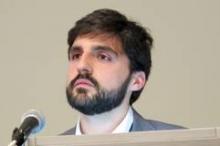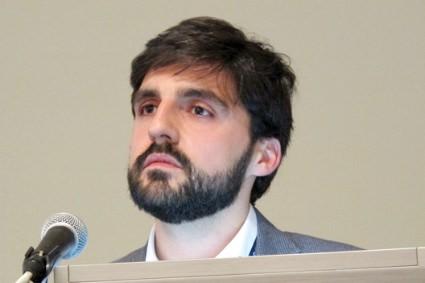User login
NEW YORK – The safe, cheap, readily available medication N-acetylcysteine may be effective against difficult-to-treat compulsive grooming disorders, a trans-Atlantic study showed.
In a case series of six patients treated for trichotillomania (hair pulling) and/or skin excoriation (skin-picking disorder, or SPD) as comorbidities to an impulse control or affective disorder, treatment with N-acetylcysteine (NAC) 1,200-1,800 mg/day resulted in either complete abstinence or great improvement in self-damaging habits, said Dr. Gustavo Jesus of the Central Psychiatric Hospital of Lisbon.
Most cases show very good results of the use of NAC in difficult-to-treat grooming disorders, he said at the American Psychiatric Association annual meeting.
Although support for the use of NAC in grooming disorders comes largely from case reports, the available evidence supports his team’s findings, he added.
NAC is a precursor to cysteine, an amino acid that protects cells from oxidative stress, interacts with inflammatory mediators, and is a modulator of the glutaminergic system of neurotransmission.
The medication historically has been used to counteract acetaminophen overdose, as a mucolytic agent for the treatment of respiratory diseases, and in the treatment of contrast-induced nephropathy, polycystic ovary syndrome, and more recently, psychiatric disorders, because of its antioxidative and anti-inflammatory properties.
The agent has been studied most in schizophrenia, Dr. Jesus said, but has also been investigated in bipolar and depressive disorders, substance use problems, obsessive-compulsive disorders and impulse control disorders, including grooming disorders.
Few options
Dr. Jesus’s team, with colleagues in São Paulo, Brazil, reviewed the literature for drug treatment of trichotillomania, and found varying evidence for the use of clomipramine, desipramine, fluoxetine, olanzapine, naltrexone, and citalopram.
"Still, we are short of evidence for which medications can be used to treat grooming disorders," Dr. Jesus said.
He presented data on a case series of three Brazilian and three Portuguese patients, four of whom had SPD, one with trichotillomania, and one with both disorders secondary to conditions that included bipolar disorder, major depressive disorder, generalized anxiety disorder, and dysthymia.
Previous medications tried for their compulsive behaviors included lithium, quetiapine, fluoxetine, venlafaxine, oxcarbazepine, and gabapentin.
Two patients had complete abstinence from SPD for 10-12 months while taking NAC 1,200 mg daily. One of these patients had a relapse after 2 weeks off NAC and improved after restarting the drug. The second patient had a relapse 1 month after stopping the drug and also had improvement after restarting it, this time at a dose of 1,800 mg/day. This patient also had trichotillomania that was considered "greatly improved" with NAC 1,200 mg/day.
The remaining patients all had "great improvement" of SPD, and three had improvement of symptoms when they restarted the drug after hiatuses ranging from 2 weeks to 3 months.
Dr. Jesus emphasized that NAC treated the compulsive grooming symptoms only and not the underlying disorder. For example, one patient with SPD secondary to major depressive disorder also had pathologic jealousy and an addiction to the Internet; NAC did not diminish symptoms of either the jealousy or the addiction.
There has been only one small, randomized, double-blind placebo-controlled trial of NAC in trichotillomania to date, Dr. Jesus noted. The investigators of that study found that patients in the active treatment group had significant improvement of symptoms on both the Massachusetts General Hospital Hair Pulling Scale and the Psychiatric Institute Trichotillomania Scale (P = .001). They also found that more than half of the 50 patients were "much" or "very much" improved with NAC, compared with patients on placebo (P = .003).
Dr. Jesus did not disclose the funding source for the study but reported having no significant financial disclosures or relationships with the manufacturers of any products he discussed.
NEW YORK – The safe, cheap, readily available medication N-acetylcysteine may be effective against difficult-to-treat compulsive grooming disorders, a trans-Atlantic study showed.
In a case series of six patients treated for trichotillomania (hair pulling) and/or skin excoriation (skin-picking disorder, or SPD) as comorbidities to an impulse control or affective disorder, treatment with N-acetylcysteine (NAC) 1,200-1,800 mg/day resulted in either complete abstinence or great improvement in self-damaging habits, said Dr. Gustavo Jesus of the Central Psychiatric Hospital of Lisbon.
Most cases show very good results of the use of NAC in difficult-to-treat grooming disorders, he said at the American Psychiatric Association annual meeting.
Although support for the use of NAC in grooming disorders comes largely from case reports, the available evidence supports his team’s findings, he added.
NAC is a precursor to cysteine, an amino acid that protects cells from oxidative stress, interacts with inflammatory mediators, and is a modulator of the glutaminergic system of neurotransmission.
The medication historically has been used to counteract acetaminophen overdose, as a mucolytic agent for the treatment of respiratory diseases, and in the treatment of contrast-induced nephropathy, polycystic ovary syndrome, and more recently, psychiatric disorders, because of its antioxidative and anti-inflammatory properties.
The agent has been studied most in schizophrenia, Dr. Jesus said, but has also been investigated in bipolar and depressive disorders, substance use problems, obsessive-compulsive disorders and impulse control disorders, including grooming disorders.
Few options
Dr. Jesus’s team, with colleagues in São Paulo, Brazil, reviewed the literature for drug treatment of trichotillomania, and found varying evidence for the use of clomipramine, desipramine, fluoxetine, olanzapine, naltrexone, and citalopram.
"Still, we are short of evidence for which medications can be used to treat grooming disorders," Dr. Jesus said.
He presented data on a case series of three Brazilian and three Portuguese patients, four of whom had SPD, one with trichotillomania, and one with both disorders secondary to conditions that included bipolar disorder, major depressive disorder, generalized anxiety disorder, and dysthymia.
Previous medications tried for their compulsive behaviors included lithium, quetiapine, fluoxetine, venlafaxine, oxcarbazepine, and gabapentin.
Two patients had complete abstinence from SPD for 10-12 months while taking NAC 1,200 mg daily. One of these patients had a relapse after 2 weeks off NAC and improved after restarting the drug. The second patient had a relapse 1 month after stopping the drug and also had improvement after restarting it, this time at a dose of 1,800 mg/day. This patient also had trichotillomania that was considered "greatly improved" with NAC 1,200 mg/day.
The remaining patients all had "great improvement" of SPD, and three had improvement of symptoms when they restarted the drug after hiatuses ranging from 2 weeks to 3 months.
Dr. Jesus emphasized that NAC treated the compulsive grooming symptoms only and not the underlying disorder. For example, one patient with SPD secondary to major depressive disorder also had pathologic jealousy and an addiction to the Internet; NAC did not diminish symptoms of either the jealousy or the addiction.
There has been only one small, randomized, double-blind placebo-controlled trial of NAC in trichotillomania to date, Dr. Jesus noted. The investigators of that study found that patients in the active treatment group had significant improvement of symptoms on both the Massachusetts General Hospital Hair Pulling Scale and the Psychiatric Institute Trichotillomania Scale (P = .001). They also found that more than half of the 50 patients were "much" or "very much" improved with NAC, compared with patients on placebo (P = .003).
Dr. Jesus did not disclose the funding source for the study but reported having no significant financial disclosures or relationships with the manufacturers of any products he discussed.
NEW YORK – The safe, cheap, readily available medication N-acetylcysteine may be effective against difficult-to-treat compulsive grooming disorders, a trans-Atlantic study showed.
In a case series of six patients treated for trichotillomania (hair pulling) and/or skin excoriation (skin-picking disorder, or SPD) as comorbidities to an impulse control or affective disorder, treatment with N-acetylcysteine (NAC) 1,200-1,800 mg/day resulted in either complete abstinence or great improvement in self-damaging habits, said Dr. Gustavo Jesus of the Central Psychiatric Hospital of Lisbon.
Most cases show very good results of the use of NAC in difficult-to-treat grooming disorders, he said at the American Psychiatric Association annual meeting.
Although support for the use of NAC in grooming disorders comes largely from case reports, the available evidence supports his team’s findings, he added.
NAC is a precursor to cysteine, an amino acid that protects cells from oxidative stress, interacts with inflammatory mediators, and is a modulator of the glutaminergic system of neurotransmission.
The medication historically has been used to counteract acetaminophen overdose, as a mucolytic agent for the treatment of respiratory diseases, and in the treatment of contrast-induced nephropathy, polycystic ovary syndrome, and more recently, psychiatric disorders, because of its antioxidative and anti-inflammatory properties.
The agent has been studied most in schizophrenia, Dr. Jesus said, but has also been investigated in bipolar and depressive disorders, substance use problems, obsessive-compulsive disorders and impulse control disorders, including grooming disorders.
Few options
Dr. Jesus’s team, with colleagues in São Paulo, Brazil, reviewed the literature for drug treatment of trichotillomania, and found varying evidence for the use of clomipramine, desipramine, fluoxetine, olanzapine, naltrexone, and citalopram.
"Still, we are short of evidence for which medications can be used to treat grooming disorders," Dr. Jesus said.
He presented data on a case series of three Brazilian and three Portuguese patients, four of whom had SPD, one with trichotillomania, and one with both disorders secondary to conditions that included bipolar disorder, major depressive disorder, generalized anxiety disorder, and dysthymia.
Previous medications tried for their compulsive behaviors included lithium, quetiapine, fluoxetine, venlafaxine, oxcarbazepine, and gabapentin.
Two patients had complete abstinence from SPD for 10-12 months while taking NAC 1,200 mg daily. One of these patients had a relapse after 2 weeks off NAC and improved after restarting the drug. The second patient had a relapse 1 month after stopping the drug and also had improvement after restarting it, this time at a dose of 1,800 mg/day. This patient also had trichotillomania that was considered "greatly improved" with NAC 1,200 mg/day.
The remaining patients all had "great improvement" of SPD, and three had improvement of symptoms when they restarted the drug after hiatuses ranging from 2 weeks to 3 months.
Dr. Jesus emphasized that NAC treated the compulsive grooming symptoms only and not the underlying disorder. For example, one patient with SPD secondary to major depressive disorder also had pathologic jealousy and an addiction to the Internet; NAC did not diminish symptoms of either the jealousy or the addiction.
There has been only one small, randomized, double-blind placebo-controlled trial of NAC in trichotillomania to date, Dr. Jesus noted. The investigators of that study found that patients in the active treatment group had significant improvement of symptoms on both the Massachusetts General Hospital Hair Pulling Scale and the Psychiatric Institute Trichotillomania Scale (P = .001). They also found that more than half of the 50 patients were "much" or "very much" improved with NAC, compared with patients on placebo (P = .003).
Dr. Jesus did not disclose the funding source for the study but reported having no significant financial disclosures or relationships with the manufacturers of any products he discussed.
AT APA 2014
Key clinical point: Finding medication with a proven track record of treating grooming disorders is difficult.
Major finding: N-acetylcysteine was effective at treating skin-picking disorder and trichotillomania in patients with compulsive behaviors secondary to other disorders.
Data source: A literature review and case series involving six patients.
Disclosures: Dr. Jesus did not disclose the funding source for the study but reported having no significant financial disclosures or relationships with the manufacturers of any products he discussed.

